20 YEARS LATER
CELEBRATING THE 20 YEAR ANNIVERSARY OF SYRACUSE'S NATIONAL CHAMPIONSHIP WIN SPORTS EXTRA
6 APRIL, 2023
W | Hometown hero
Jim Boeheim’s hometown, Lyons, held a “Jim Boeheim Day” after the team won the 2003 title Page 4
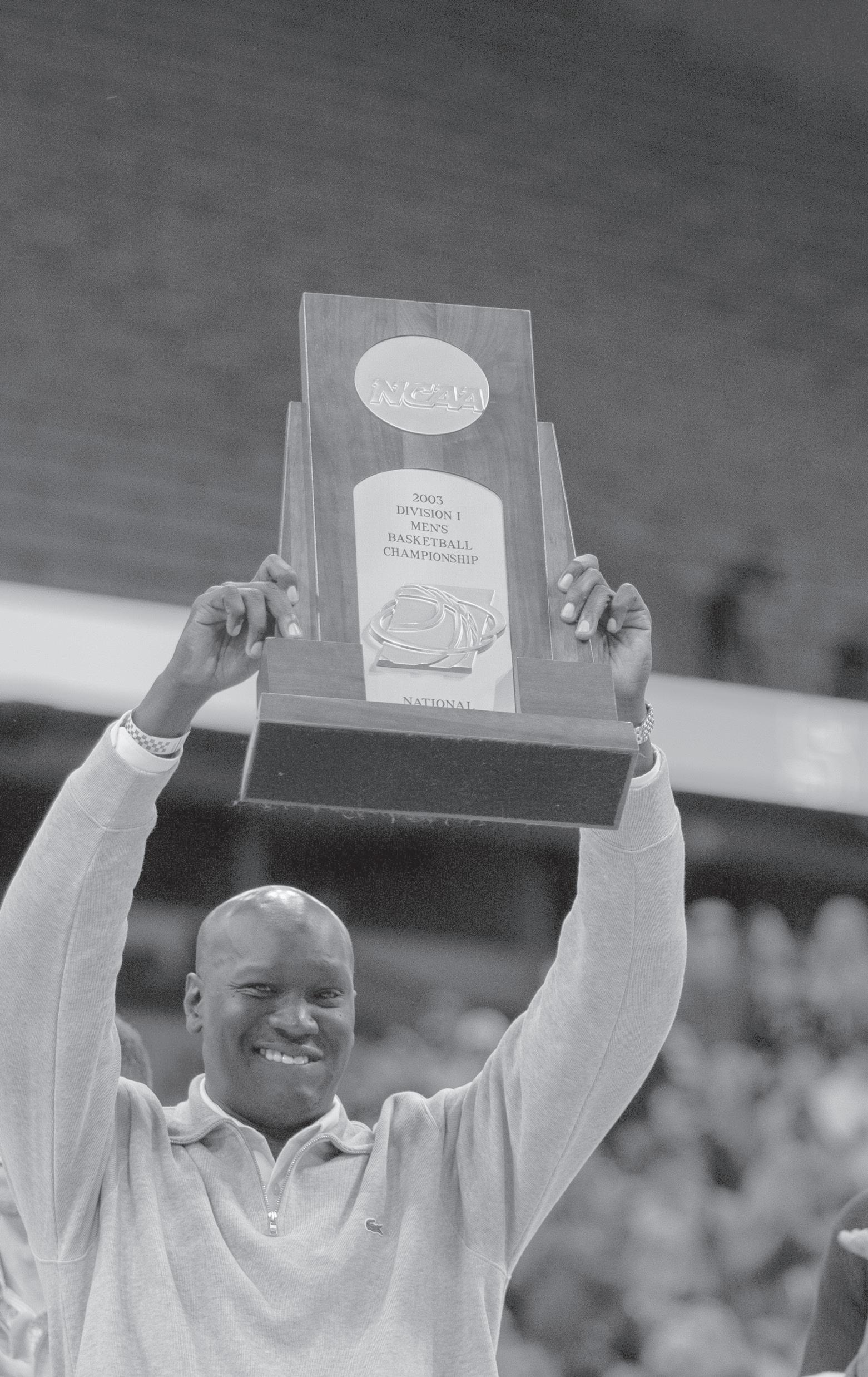
I | Full circle
Syracuse fell in the 1987 title game in New Orleans before winning the 2003 championship in the same exact stadium Page 12
N | Surreal experience
Syracuse’s Sour Sitrus Society pep-band stood courtside for the 2023 title game, rallying the crowd through its tunes Page 14
SPONSORED BY

the independent student newspaper of syracuse,
the independent student newspaper of syracuse, new york
The Daily Orange is an independent, nonprofit newspaper published in Syracuse, New York. The editorial content of the paper — which started in 1903 and went independent in 1971 — is entirely run by Syracuse University students.

The D.O., a 501(c)(3) nonprofit, is editorially and financially independent from SU, and the paper receives no funding from the university. Instead, The D.O. relies on advertising revenue and donations to sustain operations.
This fall, the paper will be published Monday and Thursday when SU classes are in session. Special inserts are published on Thursdays before home football and basketball games. The D.O.’s online coverage is 24/7, including while SU is on break.
To show your support to The D.O.’s independent journalism, please visit dailyorange.com/donate. Donations are tax deductible.
Letter from the Editor

Dear readers,
On April 7, 2003, Syracuse men’s basketball won its first-ever and, still, only NCAA Championship, defeating Kansas 81-78 in the Superdome in New Orleans, Louisiana. It marked the only title under former head coach Jim Boeheim, who retired at the end of the 2022-23 season. Boeheim, from Lyons, New York, a town about 45 minutes west of Syracuse, built his foundation for his playing and coaching legacy in the small town. He later coached Gerry McNamara and Hakim Warrick, who were members of the championship winning team that had their jerseys retired in the Dome rafters in March 2023. The 2003 championship marked a full circle moment for Boeheim and the program as in 1987, the Orange lost the title game in New Orleans. They fell again, this time to Kentucky, in 1996 before securing the title in 2003 in the same city and arena as the 1987 loss. Along the 2003 NCAA Tournament journey were 30 members of Syracuse’s pep-band, Sour Sitrus Society, who also witnessed “the block” that prevented the Jayhawks from tying the ball game in the final seconds. In commemoration of the 20th anniversary of the title, the Daily Orange’s 2003 anniversary guide has everything you need to know about the team and game through archived and new stories.
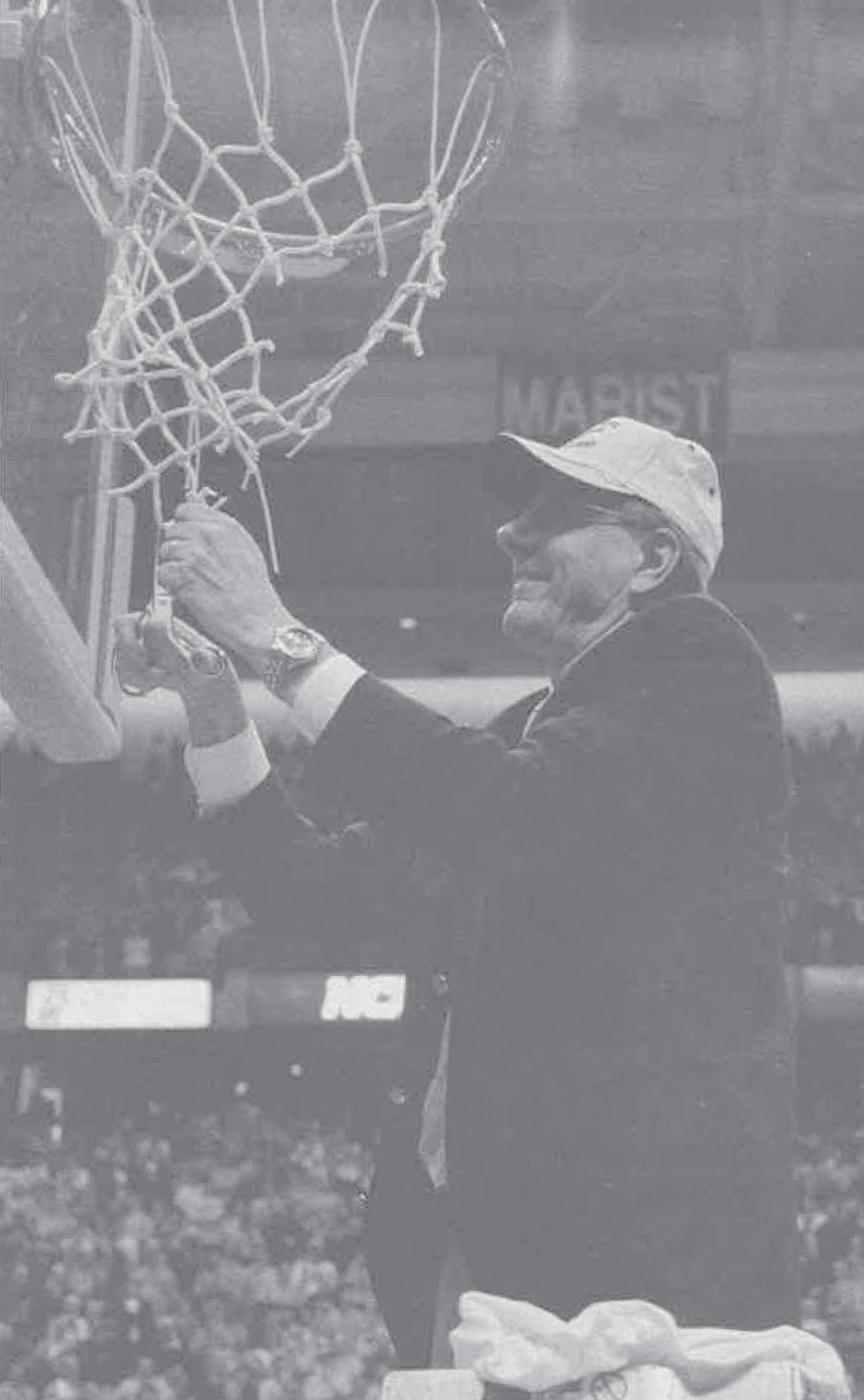
Thanks for reading,
Cole Bambini Sports Editor
2 april 6, 2023
about
Sports Editor Cole Bambini Presentation Director Santiago Noblin Digital Design Director Stephanie Zaso Photo Editor Meghan Hendricks Asst. Sports Editor Tyler Schiff Asst. Sports Editor Wyatt Miller Design Editor Eva Morris Design Editor Bridget Overby Design Editor Yesmene Chikha Design Editor Arlo Stone Asst. Illustration Editor Lindy Truitt Asst. Digital Editor Max Tomaiuolo Asst. Digital Editor Zak Wolf Asst. Copy Editor Colin Yavinsky Asst. Copy Edi tor Cooper Andrews I.T. Manager Mark Nash I.T. Manager Davis Hood Business Manager Chris Nucerino Advertising Manager Chloe Powell Fundraising Coordinator Mira Berenbaum Business Asst. Tim Bennett Circulation Manager Steve Schultz Student Delivery Agent Tyler Dawson Richard Perrins EDITOR-IN-CHIEF Rachel Raposas MANAGING EDITOR Henry O’Brien DIGITAL MANAGING EDITOR Cretive direction by Santiago Noblin Photos courtesy of Photos Courtesy of Spencer Tulis (Finger Lake Times), Finger Lake Times, Brian Young and Alyson Wasko Photos taken by Meghan Hendricks (Daily Orange Photo Editor), Amy Young and Natalia Jimenez (Daily Orange Archives), & The Daily Orange Archives The D.O. is published weekdays during the Syracuse University academic year by The Daily Orange Corp., 230 Euclid Ave., Syracuse, NY 13210. All contents Copyright 2022 by The Daily Orange Corp. and may not be reprinted without the expressed written permission of the editor-in-chief. The Daily Orange is in no way a subsidy or associated with Syracuse University. All contents © 2022 The Daily Orange Corporation Editor@dailyorange.com News@dailyorange.com Opinion@dailyorange.com Culture@dailyorange.com Sports@dailyorange.com Digital@dailyorange.com Design@dailyorange.com BUSINESS 315-443-2315
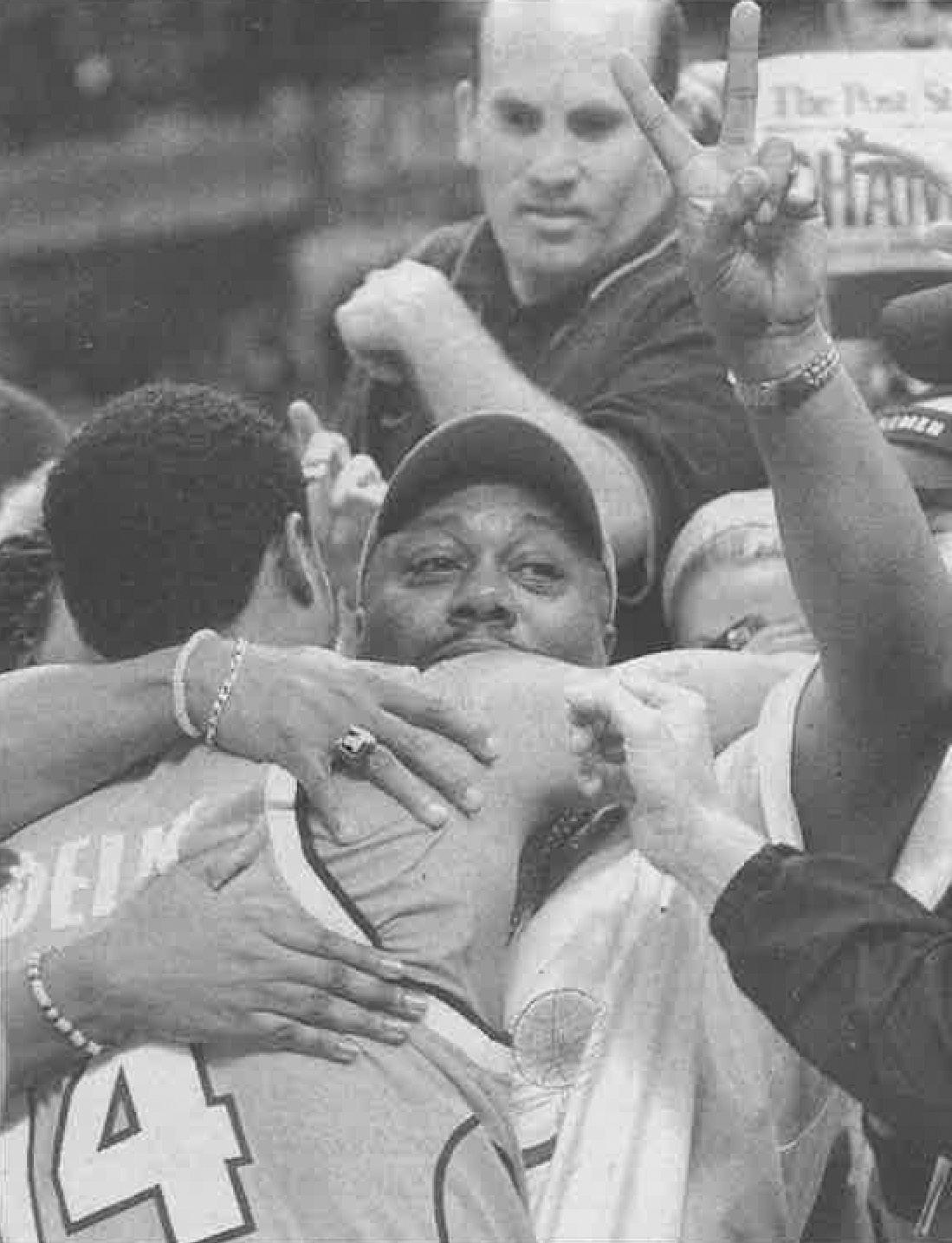

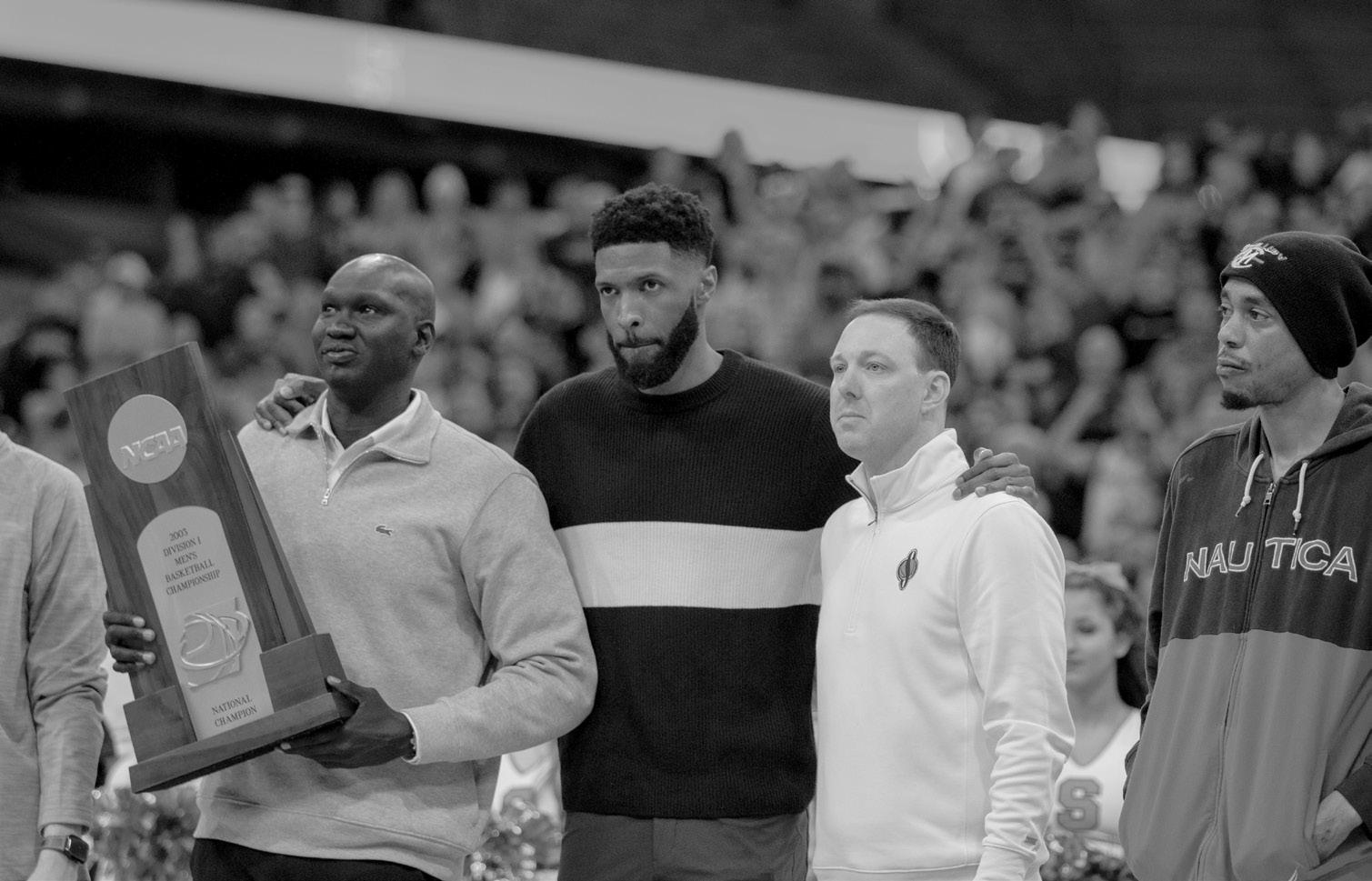



april 6, 2023 3
Champions
Syracuse defeated Kansas 81-78 on April 7, 2003, to win its firstever national championship and the only one under Jim Boeheim
By Pete Iorizzo 2003 reporter
NEW ORLEANS – When it finally happened, there were no shouts of jubilation or tears
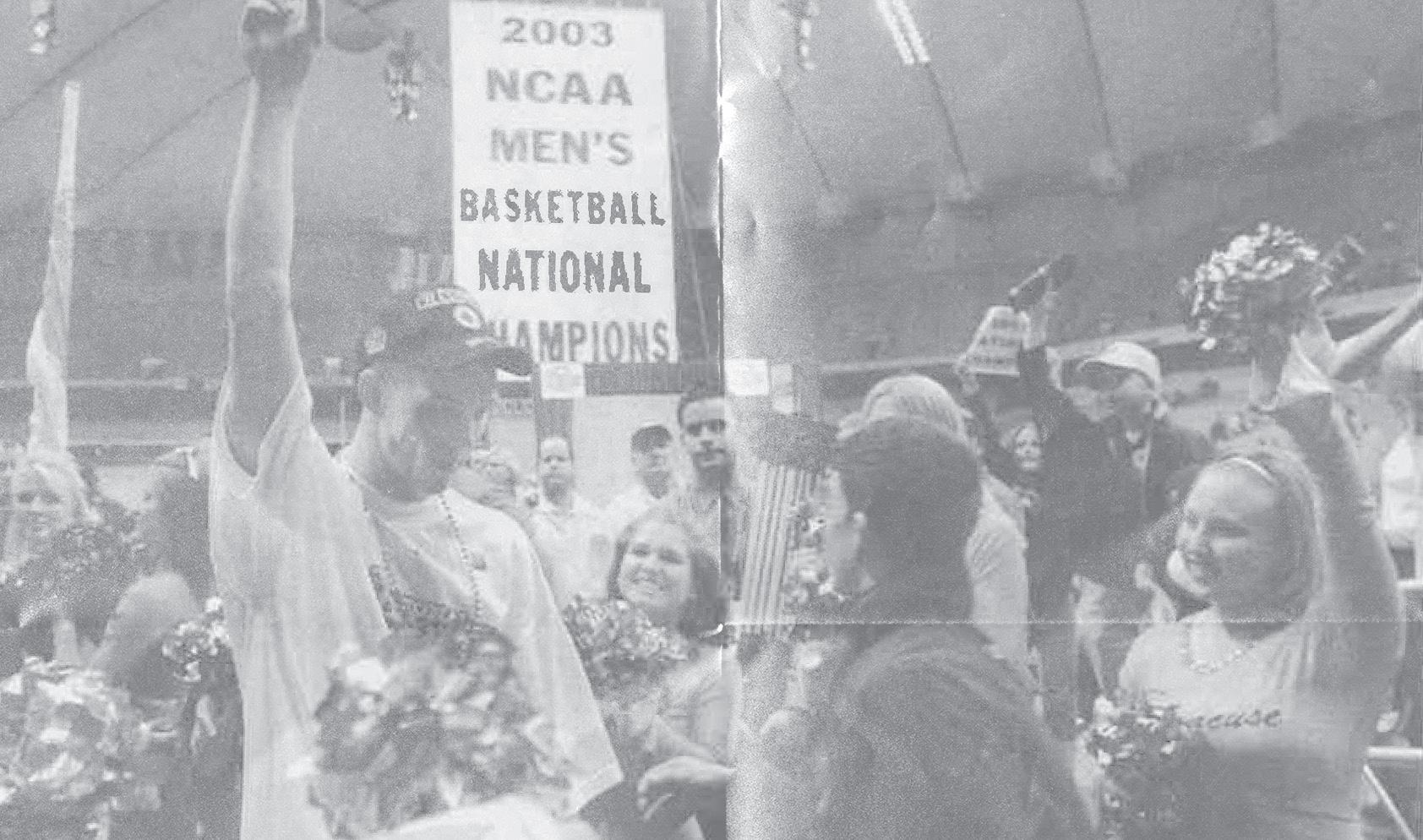
In fact, Jim Boeheim barely cracked a smile.
Seconds after winning his first national champi onship — and the first in Syracuse men’s basketball history — Boeheim simply walked over to Kansas coach Roy Williams and said congratulations.
“Well, I don’t feel any smarter yet,” Boeheim, SU’s 27-year head coach. “Maybe tomorrow. As I said before the tournament, want to win this thing. I’m tremendously happy.”
Meanwhile, 15 feet away, the Orangemen danced and celebrated, having just beaten sas, 81-78, in front of 54,524 at the Louisiana Superdome. They rejoiced partly out of after nearly blowing a 12-point second-half
With 24 seconds left, SU guard Kueth made one of two free throws to give Syracuse an 81-78 lead. Kansas’ Kirk Hinrich missed 3-pointer with 14 seconds left, but the Jayhawks quickly fouled Hakim Warrick, who missed free throws
Then Warrick made what will no doubt become the most famous block in Syracuse history.
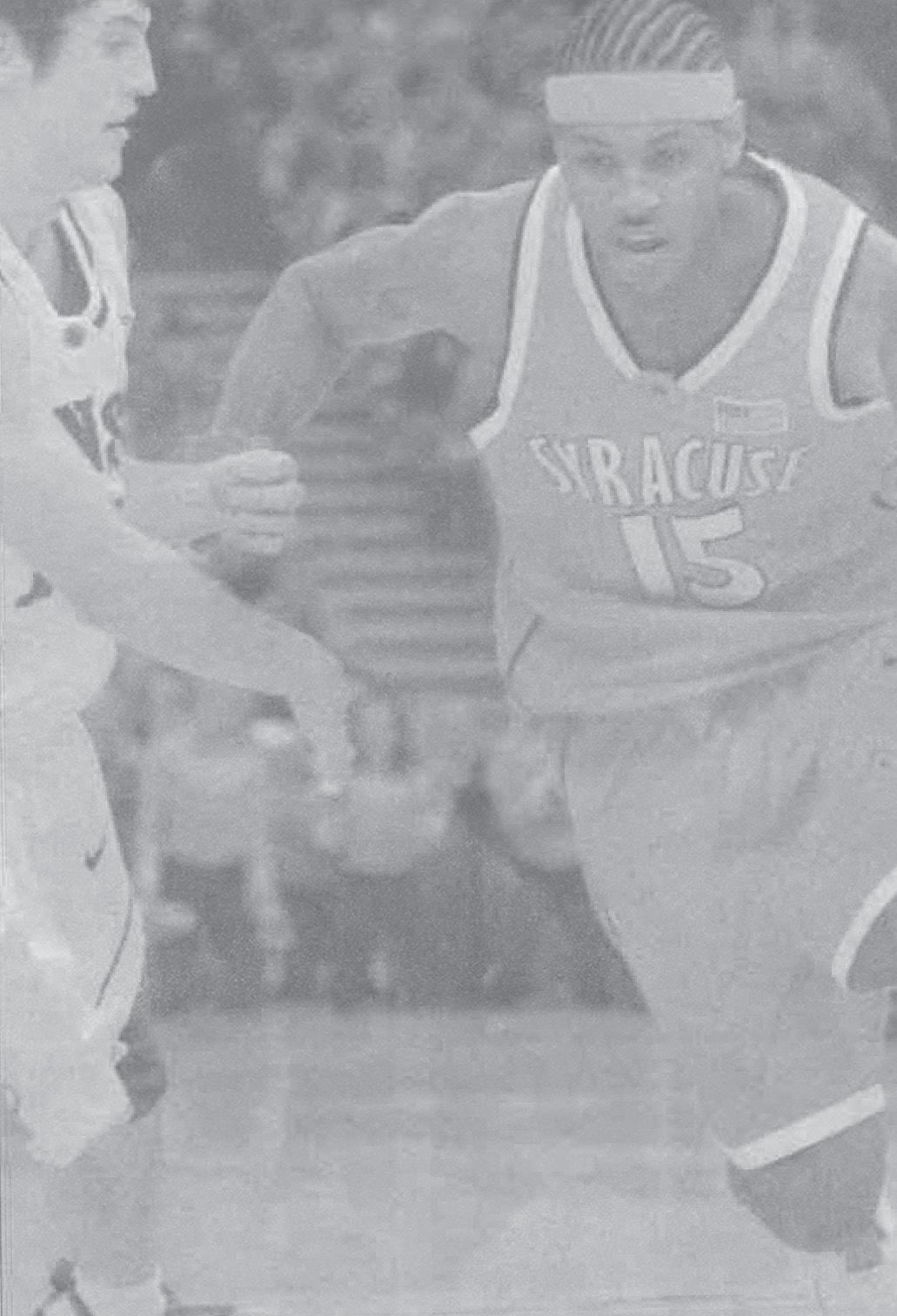

4 april 6, 2023
happened, of joy. smile. champibasketball Kansas
congratulations. yet,” said “Maybe tournament, I happy.”
Orangemen beaten KanLouisiana relief second-half lead.
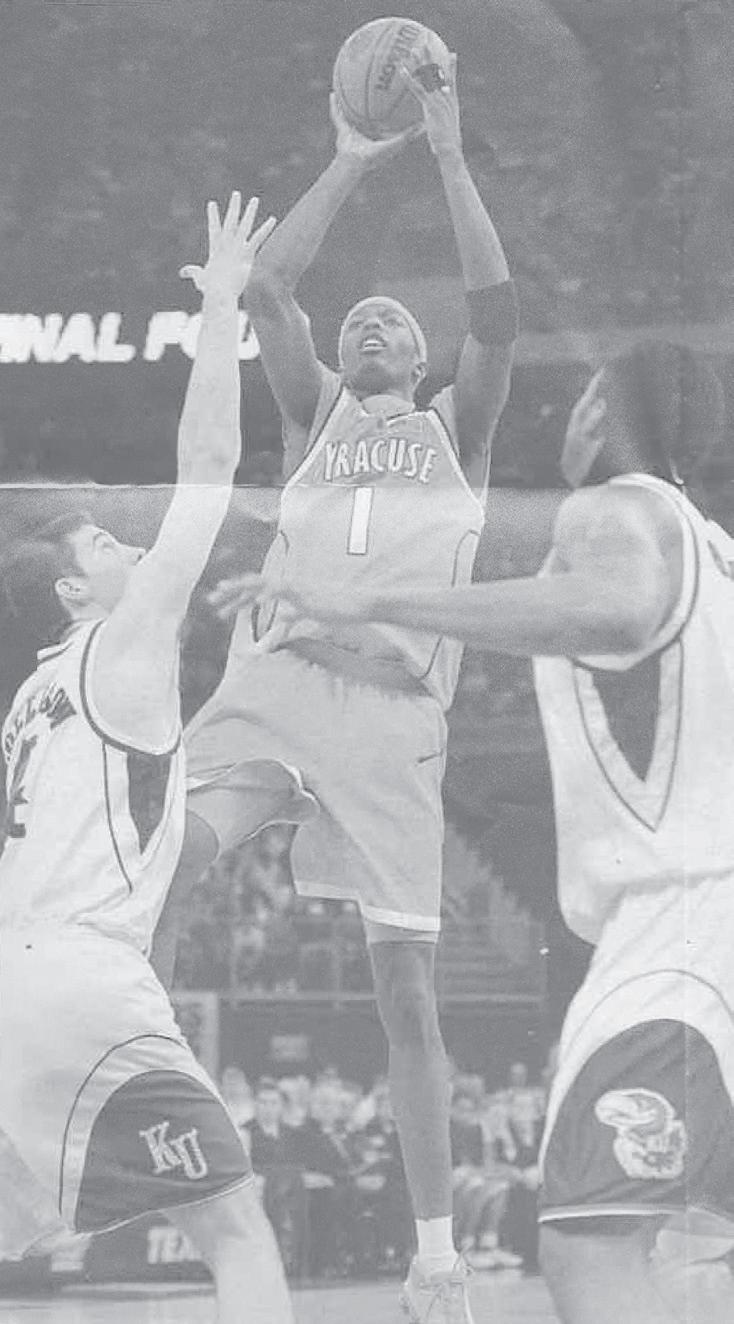
Duany Syracuse missed a Jayhawks missed both become history. He
stretched all 6-foot-8 of his lanky frame to knock away Michael Lee’s would-be game-tying 3-point try with 1.5 seconds left.
“I definitely wanted to go out there and just try to make a play after missing the free throws,” Warrick said. “I saw a guy open in the corner, and I knew they needed to hit a 3, so I just tried to fly at him. I didn’t want it to be another one of those Keith Smart shots.”
Kansas had time for one last 3-point try, but Hinrich’s desperate heave from the right corner missed everything and safely nestled into Duany’s hands.
Minutes after the game, the Syracuse fans chanted “One More Year!” begging Carmelo Anthony, who won the NCAA Tournament’s Most Outstanding Player award, to forgo the NBA Draft. Anthony led Syracuse with 20 points and 10 rebounds last night.

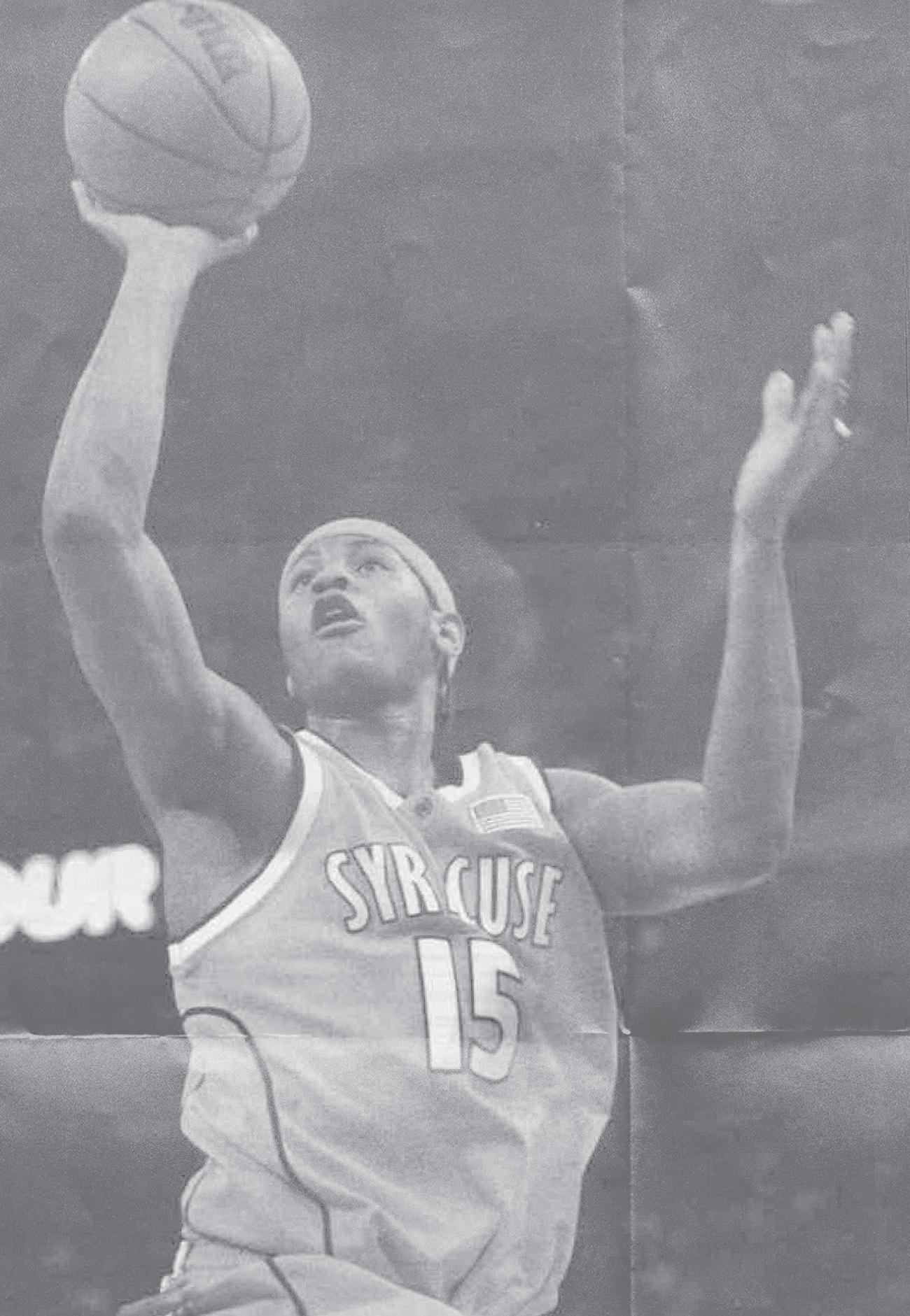
“I’ve never had a feeling like this,” Anthony said. “This is the best feeling I’ve ever had in my life.”
After the on-court celebration, Anthony hugged his mother, Mary, who sat in the front row.
“I just told him I love him very much,” Mary said as tears streamed down her face. “I’m so
proud of him.”
Nick Collison and Keith Langford each had 19 points for Kansas. Williams, the Jayhawks’ 15-year head coach, now has the second most NCAA Tournament wins of any coach without a national championship.
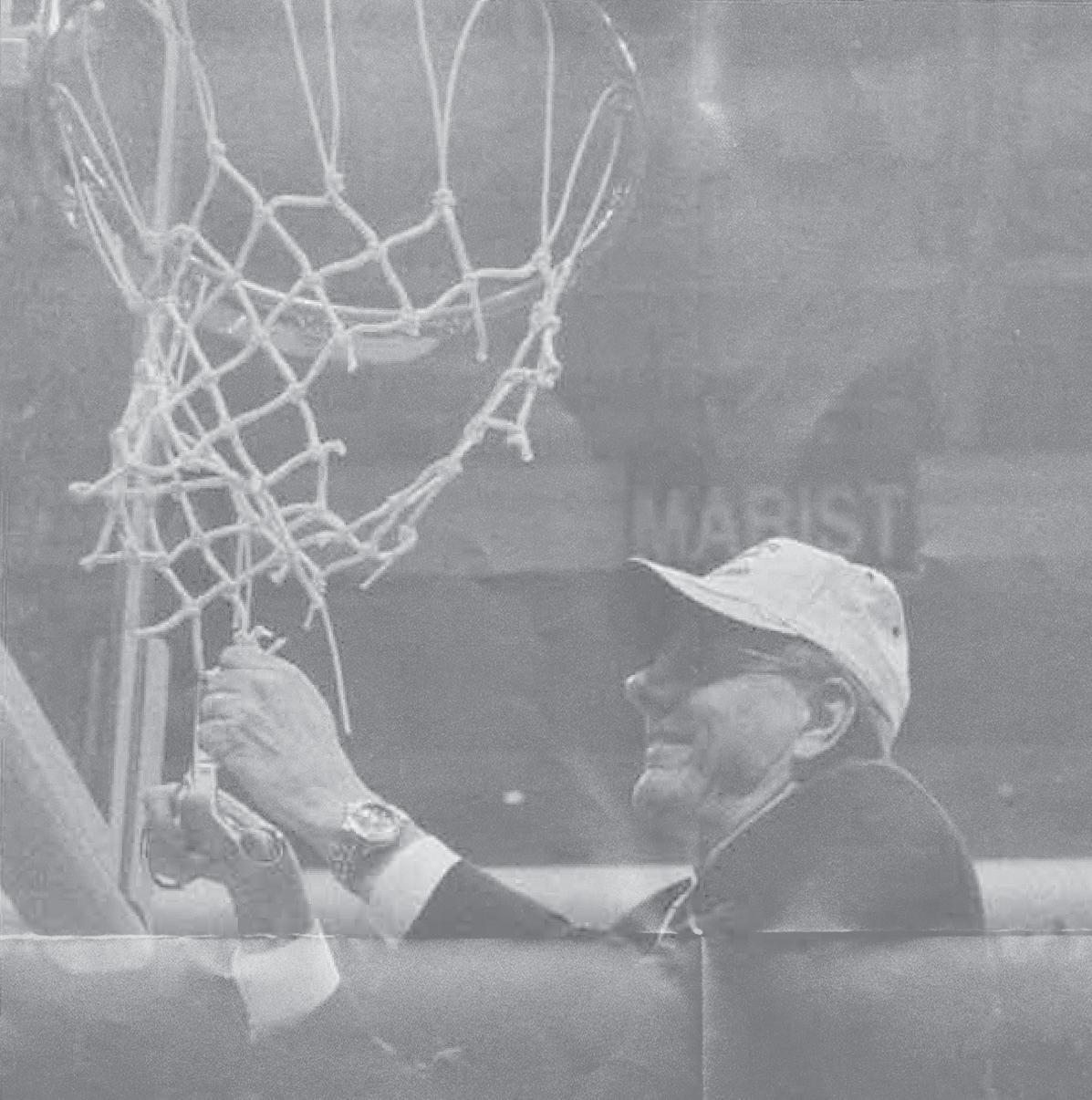
“This is one of those times I feel so inadequate as a coach and so inadequate as a person,” Williams said.
Craig Forth center on the 2003 team
“There’s nothing I can say to change the way my kids feel, nothing that can change the way I feel.”
Despite being down 10 with 6:55 remaining, his Jayhawks never quit. They closed the score to 78-73 after a Hinrich dunk with 2:36 left. SU guard Billy Edelin hit a layup for Syracuse, but Hinrich alley-ooped to Collison to keep the Orangemen’s lead at five.
Kansas pulled to within three early in the second half, but poor free-throw shooting held it back in the middle stages. At one point, the Jayhawks missed seven straight from the line.
“You try to make a free throw,” Collison
said. “You miss, you make, there’s nothing else you can do.”
A Bourbon Street-style celebration could have broken out well before midnight on Marshall Street. The Orangemen led, 53-42, at halftime, and their lead ballooned to 18 at one point during the first half behind six 3-pointers and 18 points from Gerry McNamara.
During a 17-5 SU run, McNamara hit back-to-back 3-pointers, putting Syracuse ahead, 23-14, early. McNamara shot 6 of 8 from behind the arc in the first half and 6 of 10 overall.
“I just got off early,” McNamara said. “I knew that if we were going to be successful I’d have to make my shots. I got the looks in the first half and the guys carried us in the second half.”
The onslaught continued when the Orangemen hit five consecutive shots — including two McNamara 3-pointers — in the half’s last seven minutes. After a Duany 3, SU led, 47-29.
Kansas never established its up-tempo game
because of Syracuse’s first-half 56-percent shooting, including 77 percent from 3-point range. Though the Jayhawks seemed to gain momentum toward halftime, they blew two opportunities to get back in the game.
With Kansas down 12, guard Keith Langford made a dazzling cut from the right corner and hit a layup. That sent the Kansas fans into hysterics, but those feelings quickly subsided when McNamara answered with a 3-pointer.
After Syracuse missed two consecutive shots, Anthony threw a streaking Langford to the ground on his layup try. The referees whistled Anthony for an intentional foul, but Langford missed the second of two free throws.
Then, on the ensuing possession, Hinrich missed a layup, and the Jayhawks lost the ball out of bounds. Anthony drilled a 3-pointer on the other end, giving the Orangemen a 53-40 lead.
After the game, the Orangemen, who pulled out a close one yet again, reflected on the win. Some were lost for words.
“Talk to me in two hours when it hits me,” SU center Craig Forth said. “I’ll have to sit down. I’m sure every person in the nation will try to describe this. I don’t think you can.”
archive@dailyorange.com
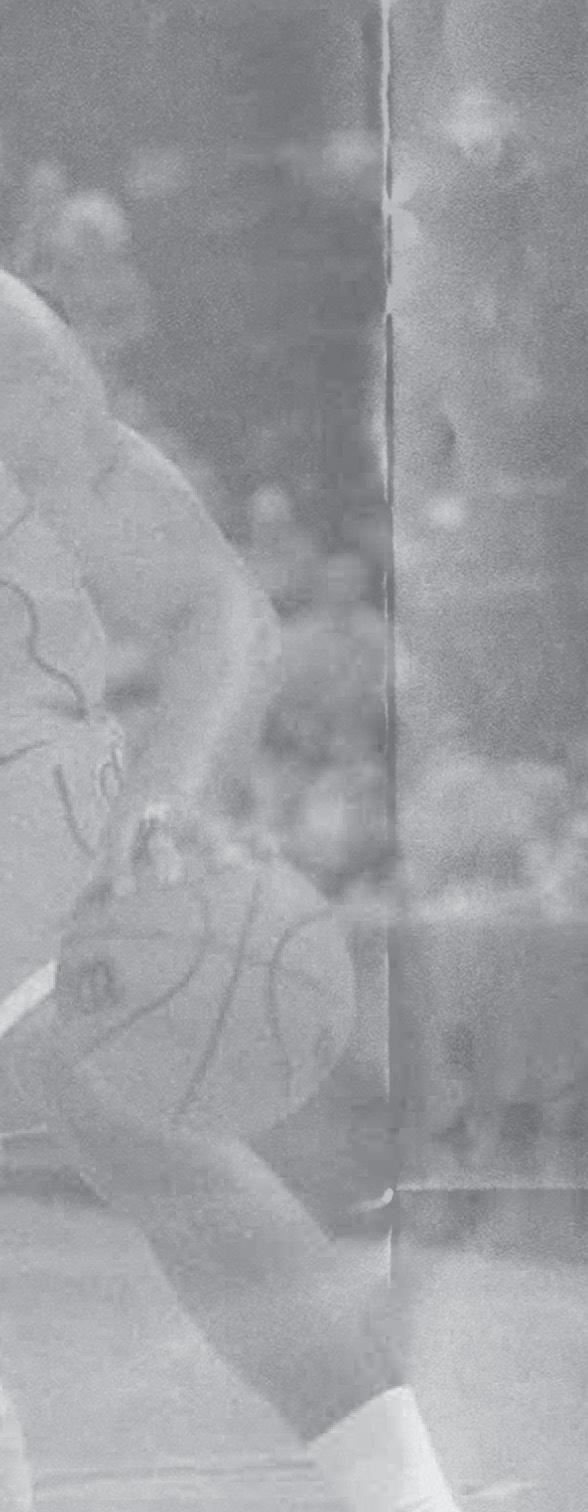
I’m sure every person in the nation will try to describe this. I don’t think you can.
dailyorange.com 2003 anniversary guide S
Head coach Jim Boeheim wins the first national championship title for SU on April 7. 2003. The Orangemen defeated the Kansas Jayhawks 81-78 in a buzzer beater final game.
Lyons Legend
By Anish Vasudevan senior staff writer
LYONS, N.Y. — A nightmarish layer of subfreezing air emerged above upstate New York on a Thursday in 2003. By Friday morning, half an inch of ice had accumulated throughout the region. Freezing rain morphed into snow and sleet. By Saturday night, trees and powerlines littered the
ground. A travel warning was put in place. Airports closed.
At the storm’s peak, the Rochester Gas and Electric Corporation estimated 211,000 people were without power. Among those were roughly 3,600 residents in Lyons, New York, who had a basketball game to watch on April 7.
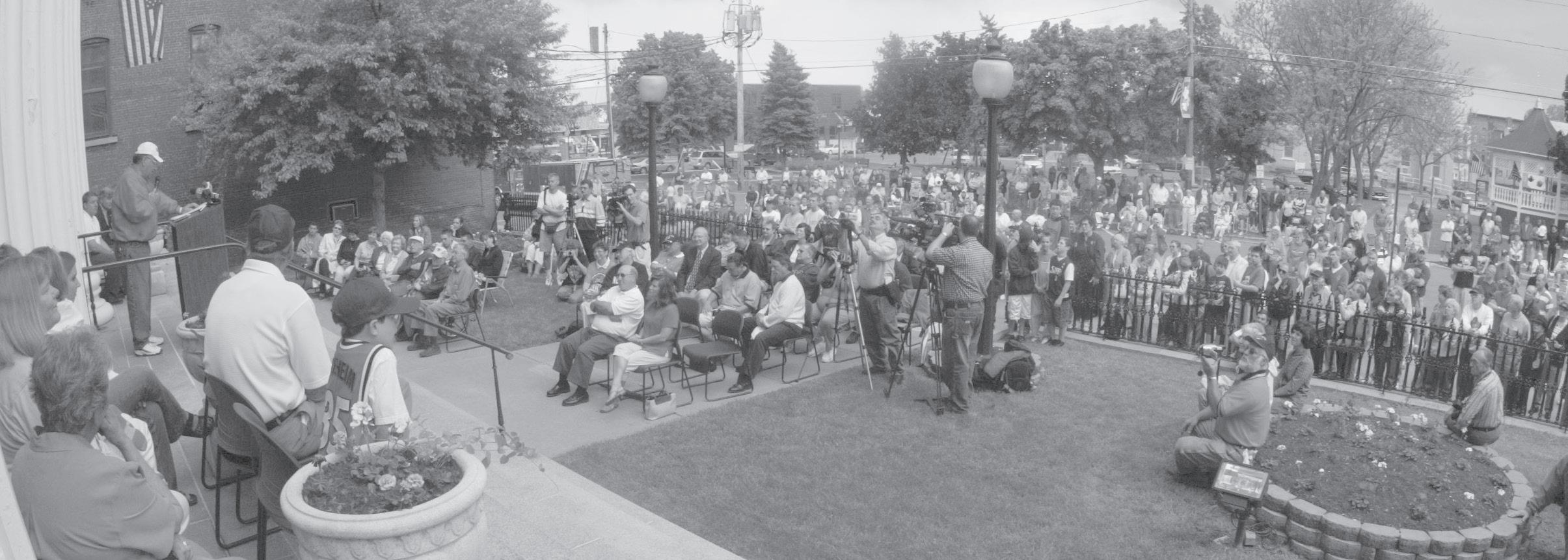
The town’s wunderkind, Jim Boeheim,
was coaching in the national championship.
A few residents in Lyons still had power. The rest dispersed to find a working television. Some went to a Niagara Falls casino. Others went to a hotel in nearby Geneva. Tony Patanzo ventured to his in-laws’ house in Clyde, the town over. Jim Blandino went to his cousin’s place just outside of Lyons.
Somehow, all of Lyons managed to watch Boeheim win his only title. Blandino returned home after the game, still without power. He pointed to the air and yelled a message directed to Boeheim’s late father, James Boeheim Sr. “Hey Bobo, we finally got one!” The lights flickered.
“Someday, his father said he would win,” Blandino said.

6 april 6, 2023 dailyorange.com 2003 anniversary guide S
Jim Boeheim is proud to be from Lyons, New York, a town roughly 50 miles west of Syracuse, where he built the foundation of his playing and coaching career
Jim Boeheim is from Lyons, New York, a town that he never forgot about as his career progressed. The town held a “Jim Boeheim Day” the summer after the 2003 championship win.
That ensuing summer, the town held “Jim Boeheim Day” in the coach’s honor. He’d moved 50 miles east to Syracuse after graduating high school, but never forgot his hometown as his career progressed. He came back for reunions with his old team, and spoke at graduations and Lyons Hall of Fame ceremonies. He helped finance the rebuilding of the town’s library.
Boeheim is proud to be from Lyons. The town, where his persona was synonymous with the sound of a bouncing basketball, would go on to shape the foundation of his playing and coaching career.
“A lot of dedicated people live here in whatever their professions might be. Jim could be characterized by that,” said Patanzo, who’s four years younger than Boeheim. “Whatever he did, he was dedicated to it and put forth a great deal of effort.”
Established in 1811, Lyons started as the “peppermint capital of the world” when H.G. Hotchkiss moved his Hotchkiss Essential Oil Company in 1841. Hotchkiss needed cooks and plastered a poster about the jobs downtown to spread the news. Boeheim’s relatives took the job, according to Patricia Alena, who works at the Peppermint Museum.
In 1854, Boeheim’s great-grandfather opened the Boeheim Funeral Home on William Street. Boeheim grew up at the house, which is still there today.

over to Boeheim and asked if he could use his ball for one game. Boeheim shook his head “no,” pressing the ball tightly
settling in the corner. He shot around with the players before the junior varsity game at 7 p.m. After the games, he was the first
was cultivated by then-Lyons’ head coach Dick Blackwell, who taught Boeheim the 2-3 zone, though it was called a sliding zone or matchup zone at that time. Under Blackwell, Lyons’ 1962 team reached the sectional finals against East Rochester. Boeheim fell on the floor after sinking a shot to send the game to double overtime, though Lyons would go on to lose. Blandino said the loss probably haunts Boeheim to this day.
Boeheim enrolled at Syracuse that year, beginning a 60-year relationship with the university. He would return to play golf with Patanzo during the offseason at Wayne Hills Country Club every weekend. Patanzo joked his temperament was worse on the golf course than the basketball court.
against his chest with both hands. He told Blandino he could only use the ball if he could join.
It was a holiday in Lyons
Boeheim slept and ate basketball, Alena said. He practiced at one of three baskets behind Lyons Elementary School almost every day. Alena lived across the street and had a big picture window in her living room. Her dad would inform her every time Boeheim walked by.
“He’d go, ‘oh, there goes Jimmy again,’” Alena said.
When Boeheim was around 10, he went to the court with a brand new basketball. He was playing alone when Blandino, who’s six years older than Boeheim, approached him. Blandino handed his ball
Boeheim guarded Blandino like an “octopus.” Every time Blandino turned around he was face-to-face with Boeheim’s green softball cap and glasses, his hands rotating like a windmill. With the rules they were playing with, Boeheim was supposed to give Blandino space to bring the ball in. He wouldn’t do it.
“Every place
I went, Jimmy was there,” Blandino said. “He was tenacious, he really wanted to win.”
When Boeheim wasn’t playing on his own, he watched Lyons High School’s team. He was always the first to the gym before each game, his nose pressed against the doors as he waited for them to open. Boeheim always had a big smile and a quarter in his hand, ready to get his ticket, Blandino said.
Boeheim always sat on the left side of the floor, testing out three chairs before
to greet the varsity team when they left the locker room.
Years later, Boeheim would be in the locker room himself. By that time, there was a hoop in the backyard of the funeral home. Boeheim Sr. had added lights so Boeheim could play when it got dark.
While the rest of his teammates practiced for football over the summer, the younger kids in his neighborhood joined Boeheim in his backyard. He started coaching them in recreational leagues.
“He was coaching while he was in high school, quite frankly,” Patanzo said. “He was a very good coach.”
Patanzo said Boeheim’s knowledge of the game stuck out when he coached. Kids also emulated his work ethic, which made him an elite force on the basketball court despite his lanky physical stature. John Hewes, who played golf with Boeheim, remembered Boeheim Sr. telling him that Boeheim put in so much effort that he wore out a brand new pair of shoes at a basketball camp.
“He’d come home with holes in (his sneakers),” Boeheim Sr. said to Hewes.
Boeheim’s knowledge about the game
Despite Boeheim’s absence, the town’s residents kept up with him. They drove to Syracuse or watched SU play from home. They saw his early success coaching in the Big East, the heartbreak of the 1987 national championship game. Finally, in 2003, they did whatever they could to see him reach the top.
“That weekend was kind of tough weather wise but it was a tremendous experience for Jim and Syracuse,” Hewes said.
Ackie Zacharilla, who was Boeheim’s godmother, started conversations about how they could celebrate Boeheim. She formed a committee with Alena, Patanzo and others to plan a “Jim Boeheim Day.” They set up a stage at the Wayne County Courthouse. They set up chairs for players and cheerleaders from the 1962 team. They plastered a banner with Boeheim’s name on William Street.
Boeheim arrived at the event in the back of a fire engine, a maroon “Lyons” hat on his head, just hundreds of feet from his childhood home. He got out of the red truck, walked past his high school teammates and onto the stage.
"He saw all sorts of people that knew him, neighbors, friends. He was smiling through the whole thing,” Alena said. “It was a holiday in Lyons.”
anish.sujeet@gmail.com @anish_vasu

april 6, 2023 7 dailyorange.com 2003 anniversary guide S
Patricia Alena a resident of lyons

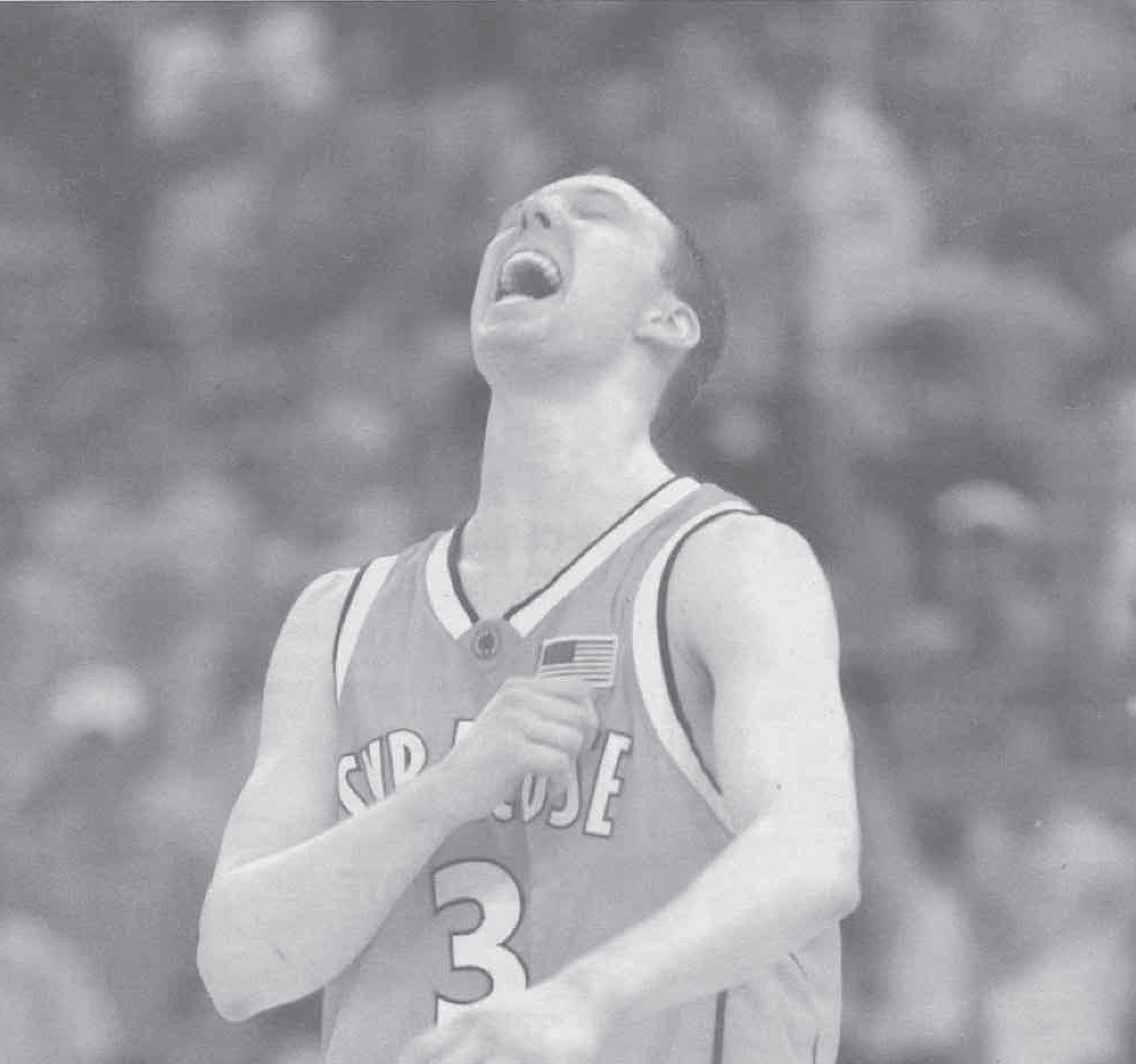
8 april 6, 2023 dailyorange.com 2003 anniversary guide S
Gerry McNamara had his jersey retired this year after being an all-time leading scorer and playing as a member of the national-championship-winning team in 2003.
‘The Mayor of Scranton’
By Anthony Alandt senior staff writer
Quadir Copeland told Gerry McNamara not to cry.
“Stay gangsta coach,” SU’s freshman guard told McNamara as he walked onto the court following Syracuse’s 72-63 win over Wake Forest. He knew McNamara wasn't an emotional person, but he could see the tears swelling in McNamara’s eyes.
The scrappy kid from Scranton, Pennsylvania was heading out for a post game ceremony to watch his No. 3 jersey raised into the rafters at the JMA Wireless Dome.
The video board flashed McNamara’s highlights. The video showed an undersized, lights-out shooter who took over Syracuse in his freshman year, a guard whose fiery explosion of talent culminated in a dog pile after beating Kansas at the end of a magical 2002-03 season. McNamara was a fighter, and it only felt right that he’d see his number retired on the 20th anniversary of Syracuse’s nationalchampionship-winning year.
McNamara is in the midst of his 15th season as a coach for the Orange. He became the 17th Syracuse basketball player to have his number retired on Saturday, with his jersey now hanging next to Hakim Warrick and Carmelo Anthony, who committed to SU in the same week as McNa-
mara. McNamara finished his four seasons with the Orange ranking first all-time in 3-point shots made and minutes played. He finished as the fourth all-time leading scorer, third in assists and third in steals.
“It was never on my mind as a player,” McNamara said about getting his jersey retired. “It was just always about winning, and I'm proud of my career because that's all I stood for.”
McNamara, dubbed “The Mayor of Scranton,” had a litany of offers out of high school. While the distance from Pennsylvania to central New York helped, he ultimately chose the Orange because of the relationship he developed with thenassistant coach Mike Hopkins. McNamara made the short trip up to campus a few times prior to his commitment, and enjoyed the familiarity of the campus and the coaching staff. Preston Shumpert was graduating, and Hopkins told McNamara that he’d be SU’s starting point guard.
It felt like he was playing at home. The moment was never too big for McNamara, a freshman leading a young Syracuse lineup that featured just one senior.
McNamara quickly burst onto the scene, averaging 13.3 points per game through 35.7% 3-point shooting in his first year. He became SU’s go-to shooter in the clutch, routinely hitting shots in key situations. Shots like the game winning 3 to beat
Gerry McNamara, SU’s fourth all-time leading scorer, saw his number retired on the 20th anniversary of Syracuse’s national-championshipwinning year

Notre Dame became inked in history — a staple found in a career that accumulated more than 400 3-pointers. On Syracuse’s NCAA Tournament run he averaged 13.3 points per game. In the national championship game, he poured in 18 points on 6-of-10 shooting from beyond the arc.
“I had a good career, but the fact that I was always going to be tied to that first year and the national championship, that's such a special, unique situation,” McNamara said.
Today, pulling up from beyond the arc is common, but that wasn’t basketball back then, Warrick said. But McNamara’s game was based around his unique ability to stop on a dime and score on a pullup three. On his senior night, the Dome was packed with nearly 6,000 people from his hometown. A similar number showed up on Saturday afternoon to watch his name get stamped in Syracuse history.
The whole 2003 team, which head coach Jim Boeheim called the best group of players he’s ever coached, hadn’t been together for years. Most of them are fathers now, some entered the collegiate
coaching ranks and one — Anthony — had a likely Hall of Fame career in the NBA.
Copeland called McNamara “a dog” who could shoot from anywhere on the court.
“Seeing him be fearless, make those shots, make those tough shots, it just made you want to go out there and play harder,” Warrick said.
Before SU revealed McNamara’s jersey retirement back in November, McNamara was told one day before practice that he was going to be mic’d up. It didn’t phase him — he thought it was just going to be another media piece for the school website.
Boeheim ended practice and called him to watch the video board with the team. A jersey announcement video played. McNamara wasn’t surprised. “This has to be my jersey,” McNamara said.
But Saturday was different. McNamara’s family was behind him watching the No. 3 enshrined in Syracuse history forever. Over 24,000 fans were there to celebrate him and Warrick. His teammates from that 2003 season stood behind him.
“Stay gangsta coach,” Copeland said. anthonyalandt29@yahoo.com @anthonyalandt
april 6, 2023 9 dailyorange.com 2003 anniversary guide S
It was just always about winning, and I'm proud of my career because that's all I stood for Gerry McNamara guard on the 2003 team

10 april 6, 2023 dailyorange.com 2003 anniversary guide S
Hakim Warrick is still known for his block in the final seconds of the 2003 NCAA Championship, which prevented Kansas from tying the game.
Hak Attack
By Anish Vasudevan senior staff writer
Before Hakim Warrick electrified Syracuse’s offense with tomahawks from outside the paint, he challenged himself to do it from behind the free-throw line.
In the summer of 2001, prior to Warrick’s freshman year, he was unknown, offered a scholarship only after Julius Hodge committed to NC State. But Warrick made an empathic entrance, mimicking Michael Jordan’s dunk package to perfection in Manley Field House months before his Syracuse debut. He easily dunked from the free-throw line, pulling off Jordan’s cradle reverse slam as well.
“I still haven’t seen somebody as athletic as he was,” said Josh Pace, former Syracuse guard and Warrick’s roommate.
Warrick’s athleticism is best remembered from “the block,” which helped solidify Syracuse’s 2003 National Championship win over Kansas. But Warrick’s impact stretched further than that singular play. He led the Orange to a Big East championship his senior year, earning the tournament MVP while winning the conference player of the year award. Now, Warrick’s No. 1 is permanently in the JMA Wireless Dome rafters after SU retired it on Saturday.
No.1
Coming into the collegiate game, Warrick had a chip on his shoulder instantly, Pace said. He wanted to show people how good he really was, though he wasn’t given many opportunities as a freshman. But Warrick got better and better, Pace said, doubling
his minutes his sophomore season.
Syracuse’s success corresponded with Warrick’s improvements during his sophomore year. Andrew Kouwe said Warrick had the skill to be a great player, but he earned more confidence with another year under his belt. With most teams focused defensively on Carmelo Anthony, Warrick relished opportunities against smaller defenders.
“Carmelo being that kind of alpha dog on that team in terms of scoring ability
Billy Edelin’s inbounds pass off the glass and into the basket.
Warrick finished with 21 points, close to his team-high average of 19.8 points per game during his junior season. Demetris Nichols, who was a freshman at the time, said Warrick’s biggest strength was his consistency, which started in practice.
“He dominated practice, so he dominated the games,” Nichols said.
Every night, Warrick’s teammates and coaches expected him to score close to
UConn or any ranked school visited the Dome. He ignited the stadium with his high-flying dunking, helping the Orange string together multiple runs to control a game.
“It was a big momentum boost whenever he got a big dunk,” Kouwe said.
In South Bend, Indiana, during his senior season, Warrick received the ball at the left block three minutes into the game. He backed Notre Dame’s Dennis Latimore down before retreating back, his right heel outside of the paint.
Warrick could have easily laid the ball into the basket. But he had the length and confidence to jump over Latimore and slam in two points. Latimore didn’t even put a hand up and Syracuse went on to win the game 70-61.
“Throughout his career, he was able to use that athleticism to his advantage where it wasn’t a classic high dunk,” Kouwe said.
Warrick’s athleticism is immortalized by a play he made on the other end of the floor. Kouwe was on the bench during “the block,” and Warrick was invisible at first.
and everything, I think it helped motivate Hakim and pushed him,” Kouwe said.
When Anthony left SU after the 2002-03 season, Syracuse quickly became Warrick’s team. With championship experience, Warrick was expected to lead the Orange back to the top. Up until that point, Warrick still hadn’t earned the respect he deserved nationally.
Warrick was one of 16 finalists for the 2003 USA Basketball Men's Pan American Games Team, but he was cut. The team’s head coach, Tom Izzo, brought his Michigan State squad to the Carrier Dome on Jan. 3, 2004.
In an “emotional” game, Warrick dominated. Midway through the second half, Warrick dribbled into the paint, immediately surrounded by two defenders. Calmly, he rose over both and redirected
20-plus points. The majority of the time, that was the reality. He set an example for Nichols, who would be in the same position a few years later.
“He was going to get his numbers and do his job,” Nichols said. “He gave me the blueprint of what you’re supposed to do when you’re a leader of a team at Syracuse.”
Head coach Jim Boeheim was tough on Warrick, Nichols said, but Warrick’s preparation helped him live up to the high standards Boeheim had for all of his forwards.
“Preparation takes away the pressure because if you know that you’re prepared, you know you have the best chance to be successful,” Nichols said.
Warrick was most prepared for games against big opponents, bringing his game to another level whenever Georgetown,
Michael Lee appeared to have enough space to settle for an uncontested 3 in the left corner until Warrick rotated just in time, leapt forward and swatted the ball out of bounds.
“You’re looking at that ‘wow, Lee is wide open in the corner,’ and then here comes Mr. Go-Go gadget arms and just takes care of it,” Kouwe said.
After the game, those “go-go gadget arms” raised Syracuse’s first and only national championship. On Saturday, Warrick extended his No. 1 jersey into the air, forever etched in Syracuse history.
“You think of some of the great alltime Syracuse players, Hakim just puts himself right there with those guys and having that national championship and that iconic play is pretty special,” Kouwe said. anish.sujeet@gmail.com @anish_vasu
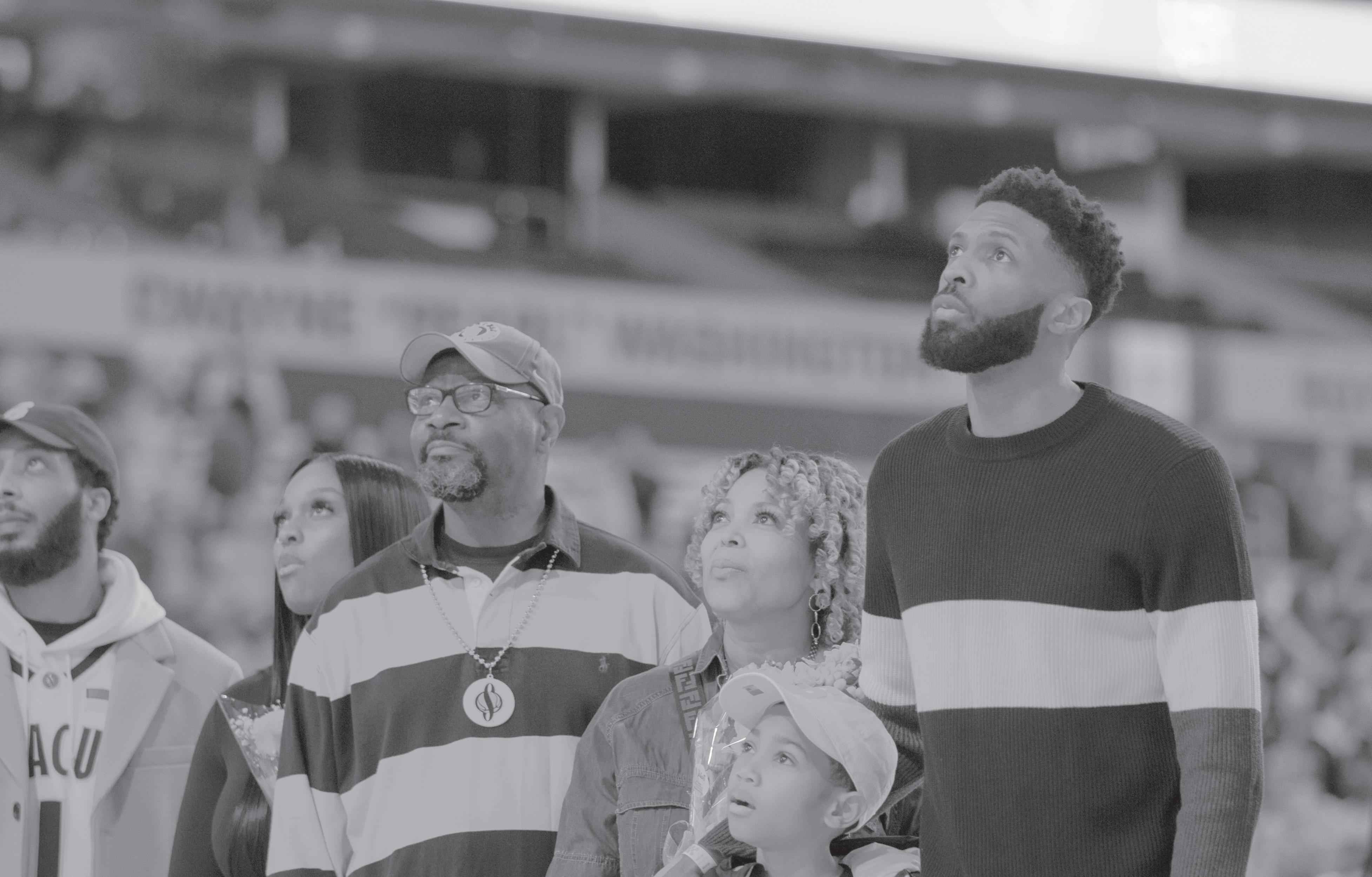
april 6, 2023 11 dailyorange.com 2003 anniversary guide S
Hakim Warrick’s athleticism is best remembered from “the block,” which helped solidify Syracuse’s 2003 National Championship win over Kansas. His jersey now hangs in the Dome rafters.
Warrick’s No. 1 jersey hangs retired in the Dome rafters
3rd Time' s the Charm
Syracuse’s title game runs in 1987 and 1996 paved the way for its 2003 championship win over Kansas
By Connor Smith senior staff writer
Before Syracuse’s 2003 national championship game against Kansas, Carmelo Anthony saw Jim Boeheim nervously pacing. “He just wasn’t himself,” Anthony recalled to Bleacher Report five years ago.
Boeheim had been in the position — twice before, in fact — of coaching in a title game, and had fallen short both times. The game against the Jayhawks was being played in the same building,
the Mercedes-Benz Superdome in New Orleans, as SU’s buzzer-beating loss to Indiana in 1987.
So, Anthony approached Boeheim. “Coach, don’t worry. We got this,” Anthony said. “We’re gonna get this done.” Syracuse did, beating Kansas 81-78 for its first and only men’s basketball national championship. Instead of losing on a last-second shot from Keith Smart like they did to Indiana in 1987, or to guard Tony Delk, who hit seven 3s in the 1996 loss to Kentucky, the Orange came
out on top in 2003. This time, it was Hakim Warrick blocking the potential game-tying shot in the final seconds, and Syracuse’s Gerry McNamara hitting six 3-pointers in the victory. And Boeheim, after 27 years as head coach and three Final Four appearances, finally had his national championship.
“The third time was the charm,” said Matt Roe, a member of the 1987 team. “The first one (in 1987), a lot of people felt like it was ours — we gave it away. So (2003) was karma in a lot of ways.”
Warrick’s block was the opposite of Smart’s shot, Roe said. With a few minutes left against Indiana, Roe sat on the bench, imagining himself giving his dad a championship ring. That gesture was supposed to show appreciation for the countless hours Roe’s dad had spent with him shooting at the YMCA in downtown Manlius and driving him to games.
Instead, Derrick Coleman missed the front end of a one-and-one with Syracuse up one. Smart put up a fallaway, baseline jumper over the outstretched

12 april 6, 2023 dailyorange.com 2003 anniversary guide S
left arm of Howard Triche with just seconds remaining. On SU’s bench, 90 feet away, Roe couldn’t tell if the shot went in. When it dropped, Roe’s heart sank. He’s watched the shot on TV several times since, but still can’t stomach rewatching the entire game. “I don’t have the heart to do it,” he said. “It hurts.”
“That's one shot that everyone will tell you where they were, where they were watching it, what they were thinking,” Roe said. “I always laugh and say, ‘well, I had a pretty good seat, too.’ And unfortunately, it was the wrong result.”
John Wallace, Syracuse’s top player in 1996, also hasn’t rewatched his national championship loss. Playing top-seeded Kentucky, Wallace scored a game-high 29 points, but fouled out. He said his only regret about the game was not shooting enough, and insisted SU would’ve won if he hadn’t fouled out. Instead, Syracuse fell 76-67.
Wallace was the first player in the Orange’s locker room after the loss, taking out his frustration on some scattered items. While he said Syracuse took no moral victories from the defeat, the deep run that year — as well as in 1987 — also “100%” helped pave the way for the 2003 championship.
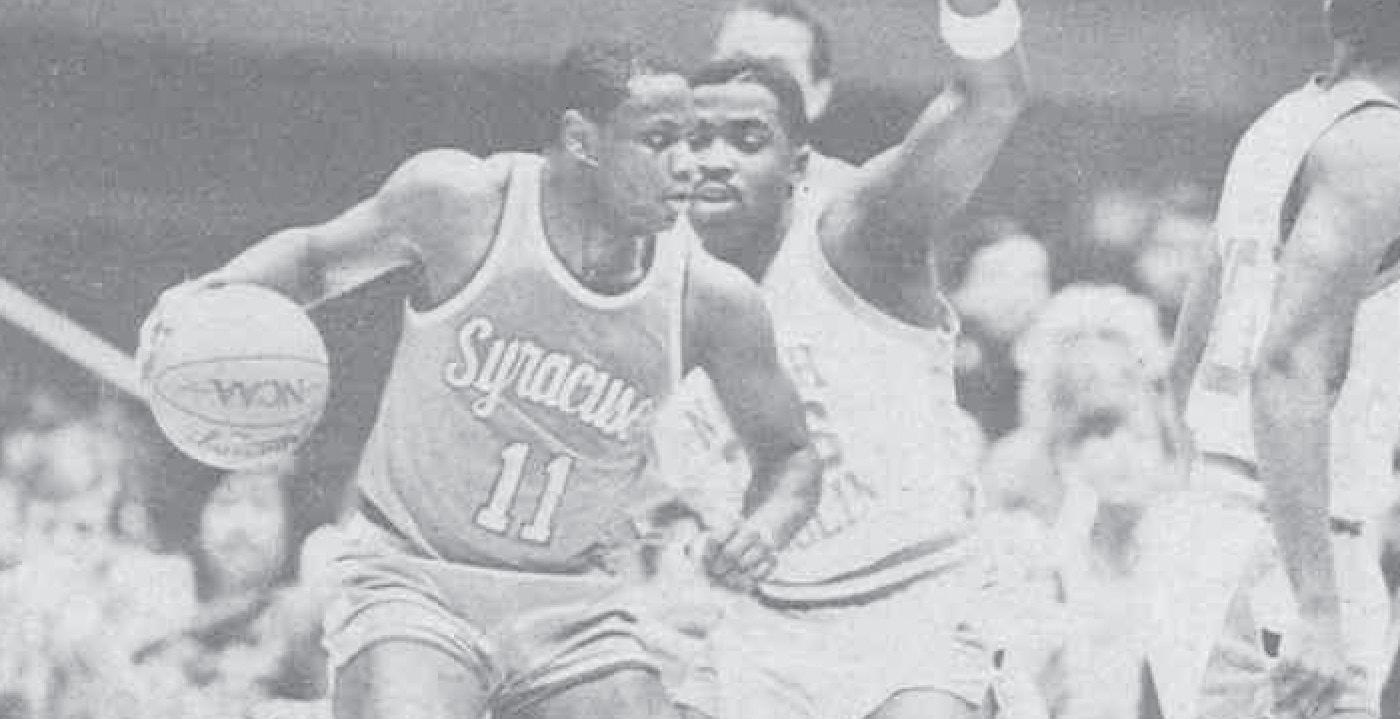
“When you bring it up, it’s bittersweet,” Wallace said of losing the 1996 title game. “But at the same time, it’s part of the ‘Cuse legacy that was a stepping stone to everything that led to us finally winning it in 2003.”
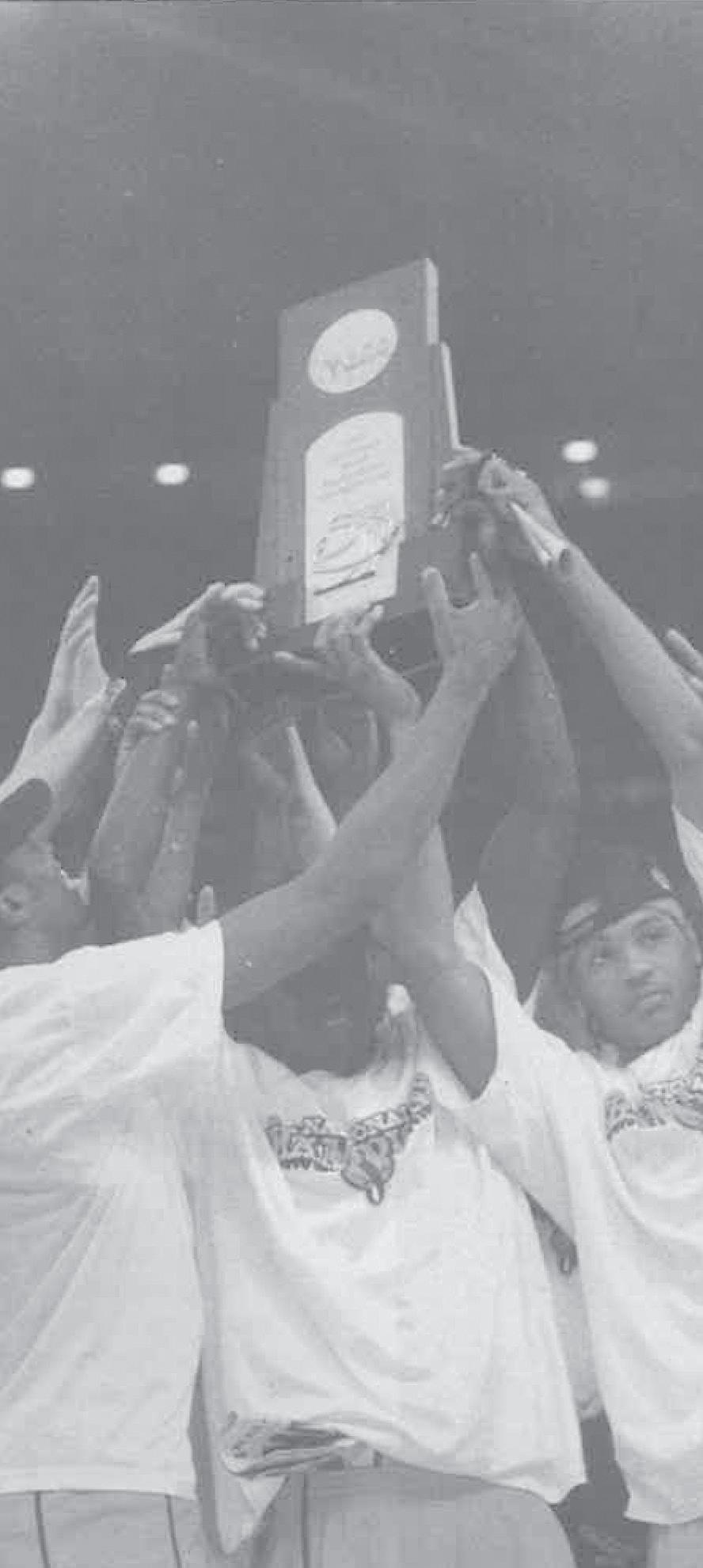
After losing to Indiana in 1987, SU players had to make a lengthy, quarter-mile trip from the court to the locker room quietly, with plenty of tears, Roe said. A solemn Boeheim walked to shake hands with Bob Knight.
While that loss was a disappointment, the Orange didn’t even expect to get to the Final Four, Roe said. The realization didn’t hit until the clock was ticking down during their Elite Eight win over top-seeded North Carolina.
“That was never really on our radar,” Roe said of getting to the Final Four. “We really were shocked as a team, I think, getting to the Final Four.”
That underdog mindset — something both the 1996 and 2003 teams also had — didn’t change in New Orleans, even as the team received a police escort and stayed in a five-star hotel. SU was the third-most talked about team that week, behind No. 1 seeds Indiana and UNLV, and didn’t face significant pressure, Roe said.
Boeheim kept his approach consistent, too. Syracuse still had its pregame meal four hours before tip-off, and Boeheim put his regular five starters, defensive assignments and opponent sets on the
chalkboard before the game, like usual.
Back in the same city 16 years later, Boeheim didn’t change much, said Clay McKnight, SU’s administrative assistant in 2003. Practice plans stayed the same, and so did Boeheim. After the Kansas win, when reporters asked him how being a national champion felt, Boeheim replied that he was the same coach as he was beforehand — not much had changed.
Throughout the 2003 tournament, Syracuse played loose, running plays three times in a row if they kept working, and beat four of its six opponents by double digits.
“It really wasn't like they weren't scared of anybody or anything,” McKnight said. “They respected the opponents, but they weren't scared of playing anybody.”
That had been evident since a lateFebruary win at Michigan State, when the Orange’s belief that they were in store for a special season went to a “different level,” McKnight said.
Like the 1995-96 team, SU had started the 2002-03 season unranked, but gradually saw its confidence grow. Wallace recalled entering the 1996 NCAA Tournament thinking the Orange could win it all. After flying home following the Elite Eight win over Kansas, fans parked on the side of the road to greet the team, and so did thousands more waiting at Manley Field House. Wallace could see the relief in Boeheim’s face as he returned to the Final Four.
Before the 2003 NCAA Tournament started, McKnight worked for 40 hours — even through the night several days in a row — on a 25 x 20 inch bracket that went on the wall of Syracuse’s old office. McKnight had never built one before or since, but had a feeling the Orange were in for a special run. Boeheim liked the bracket so much that, when the basketball staff changed offices years later to the Carmelo
K. Anthony Basketball Center, he tried to take it off the wall and bring it with him, McKnight said.
With less than two seconds remaining after Warrick’s block in the title game, McNamara sat on the bench with his arms draped over McKnight and Mike Hopkins, both stressed out. His message was the same as Anthony’s before the game.
“We got this,” McNamara said. “Don’t worry.”
And when Kirk Hinrich’s final heave landed way off, Boeheim’s arms launched into the air. As he walked toward Kansas coach Roy Williams, his face still resembled the one he had when greeting Knight in 1987, but this time, he had a national championship, and McKnight’s bracket had just one name still standing: Syracuse. csmith49@syr.edu @csmith17_
april 6, 2023 13 dailyorange.com 2003 anniversary guide S
16
The number of years in between SU’s 1987 loss and 2003 win
Syracuse’s 2003 national championship remains as its only title in program history, avenging the defeats to Indiana (1987) and Kentucky (1996).
Music Madness
By Meghan Hendricks photo editor
In 2003, John Brennan carried a pair of dirty socks with him as Syracuse battled Auburn to earn a spot in the Elite Eight. After watching the Orange squeeze by with a one-point win, Brennan decided it must’ve been because of the socks.
“At that point, I said no, I’m just holding on to the socks,” said Brennan, a member of the Sour Sitrus Pep Band. “These seem to be a good luck charm. So for the Albany games and the New Orleans games, I had these dirty socks in my pocket.”
The Sour Sitrus Society, Syracuse’s pep band, plays at the men's and women's basketball games. In the 20022003 season, the organization had 177 members and was run by students. Brennan, then a senior trumpet player, was one of the 30 members chosen by the band’s executive board to make the trip to the 2003 NCAA Tournament. The student board was also in charge of organizing music, meeting with NCAA officials and even booking hotels. Two of these board members, Chairman John MacNair
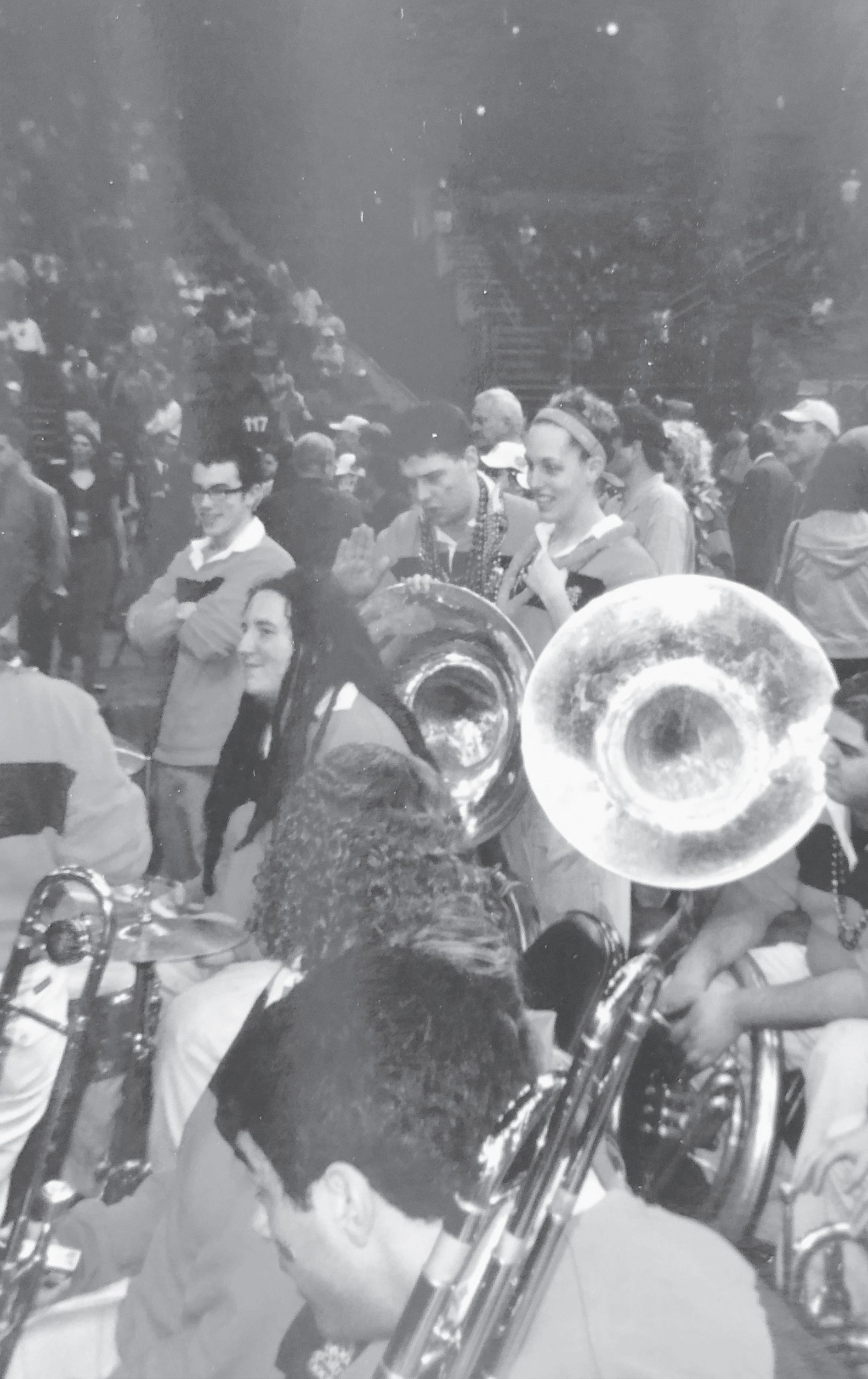
and Secretary Alyson Wasko, helped organize and traveled for the championship tournament.
“It's so difficult to look at your peers that you're friends with and be like, ‘you know, you're doing something wrong,’ or ‘this the reason why you can't travel,’” MacNair said.
Members of the band said they were selected to travel based on a point system, playing ability and overall availability. Points could be accrued throughout the semester by playing at optional service events, serving on a committee or attending women’s basketball games.
This point system was also based on seniority, band members said, with older students starting the season with more points than their younger counterparts. Brian Young, a freshman at the time, felt lucky to be selected for the roster. Young grew up in Syracuse, so getting to go to the national championship game was a surreal experience.
“I've been a Syracuse fan for as long as I can remember,” Young said. “I was fortunate my freshman year, there were not a lot of upperclassmen in my section…but by going to a bunch of
Syracuse’s Sour Sitrus Society pep band traveled throughout the 2003 NCAA Tournament.
Here’s its perspective on witnessing that title run
14 april 6, 2023 dailyorange.com 2003 anniversary guide S
women's basketball games and all the extra events…I had the opportunity to travel.”


The band traveled to each tournament game, from Boston, then Albany and eventually New Orleans. The few days between games were spent back in Syracuse going to class. The travel schedule was hectic but exciting, then-senior sousaphone player Kevin Upcraft said.
“When you're at a tournament location, you play a game, you have a day off and another game and then we bus back,” Upcraft said. “It was tough though, because you'd go from a weekend of spring break party-party to back to class.”
Despite troubles getting to the games, including navigating class schedules, several wrong turns and even a car accident, the tournament was something every member of the band remembers distinctly.
Brennan remembered the feeling of walking into the Superdome for the Final Four game, saying it was a surreal experience as they were escorted through the bowels and then out onto the court before the game. Upcraft said in comparison to the then-Carrier Dome, this was something else entirely.
“Just looking up and seeing how big it was — we had all been in the Dome hundreds of times, and this just made the Dome look small to see it from that perspective.” Upcraft said.
Every game brought a large crowd of Orange fans who helped the band’s energy and momentum, said Jason Ladd, a graduate baritone player. As part of the spirit squad, the band is responsible for helping to keep the crowd cheering even through difficult moments in the game.
The band’s performance of “The Hey Song” — actually “Rock and Roll (Part 2)” by Gary Glitter — got the entire stadium singing in the championship game, members of the band said. Throughout the season, they said the song became one of their most popular, and would always spark a chorus of obscene chants from the student section.
“It didn't matter that we didn't play it because the students just started it on their own,” Wasko said. “They just sang it at the top of their lungs because they heard it the entire season.”
Because band members are representing the university when performing in uniform, they’re expected to maintain a level of sportsmanship and professionalism. To Young’s dismay, this meant the band couldn’t rush
the court with the rest of the Syracuse fans when the buzzer sounded at the end of the championship game.
Young first traveled with the band to the Big East Tournament in New York City, but did not travel again until the Final Four. When the games started in New Orleans, he had to flip the switch from watching as a student fan to being a band member.
“When you get the rugby (the band uniform) on, you have to edit your language a bit. You’re front and center, you're right with microphones and the cameras,” Young said. “But I also didn't care,
because we had great seats for some amazing basketball. It was well worth the tradeoff.”
The band members sat courtside for every game throughout the tournament. Being so close to Hakim Warrick’s famous game-saving block against Kansas is something that MacNair still remembers in slow motion.
I remember seeing Michael Lee open, I remember the ball getting kicked out to him. It was almost like NBA Jam, where someone would come and block the ball out of nowhere,” MacNair said. “It was superhuman.”
As soon as the buzzer sounded to end the game, the band immediately kicked off the fight song followed by a chorus of other songs.
“When the game's over, you're supposed to play the fight song. And I'm chok-
ing back tears trying to play my horn as I'm pumping my fist,” Young said. “My team just won it all, the team I've been rooting for literally my entire life. And I'm there for it, front row.”
After the game, most of the Syracuse crowd in New Orleans took to Bourbon Street to celebrate the win. Some of the band members, along with head coach Jim Boeheim and the Syracuse players, joined the festivities. Choruses of “The Hey Song,” a sign that Syracuse was there, could be heard floating down through the streets of downtown New Orleans.
“People were doing all sorts of Syracuse chants. The “Let's go Orange!” and just having a great time,” Brennan said. “All of the fans that were there just went to go celebrate, and Bourbon Street was a sea of orange.”
mehendri@syr.edu
april 6, 2023 15 dailyorange.com 2003 anniversary guide S
My team just won it all, the team I've been rooting for literally my entire life. And I'm there for it, front row
Brian Young member of the 2003 sour sitrus society
Members of the Sitrus travel to Boston, Albany, and New Orleans as the Syracuse Men’s Basketball team moves through the 2003 NCAA Tournament.






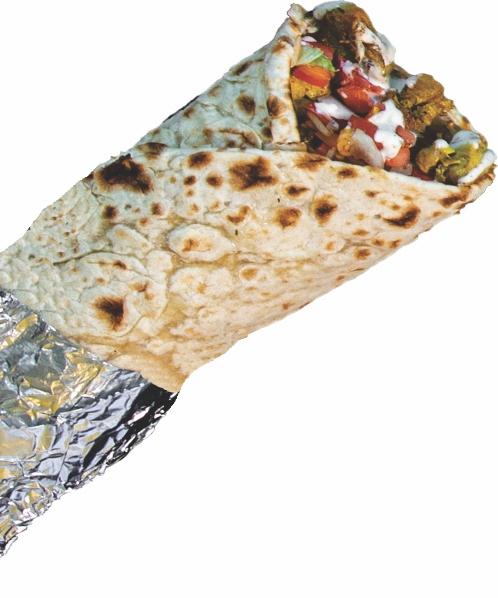


16 march 23, 2023











































